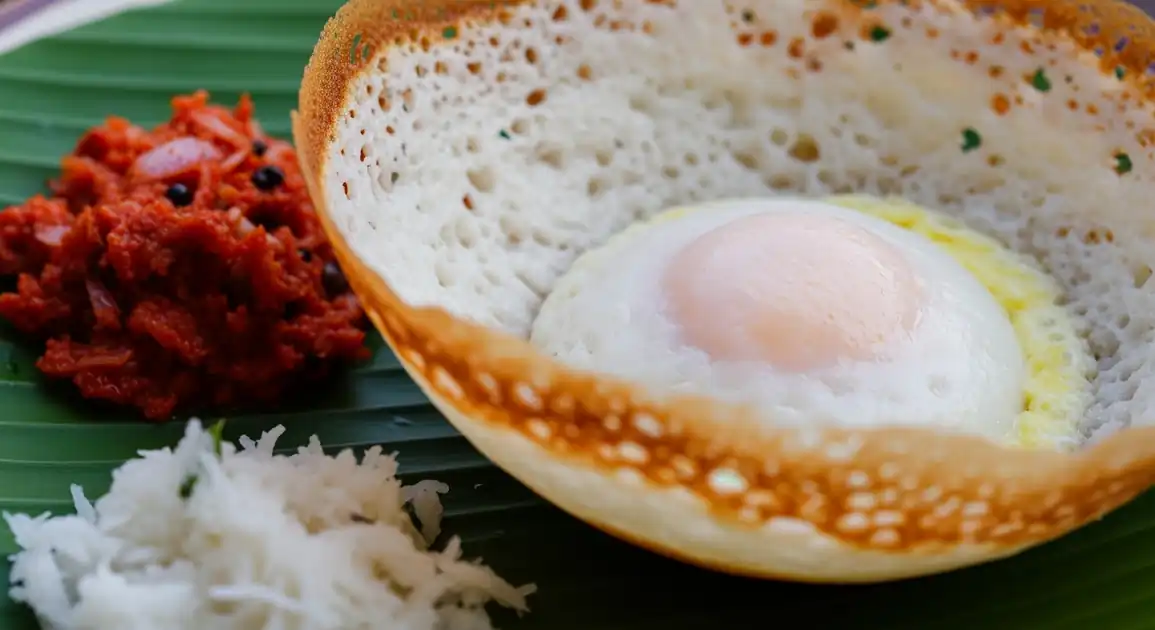Appam (Hoppers)
ආප්ප (Aappa)

Description
Hoppers (Appam) are ubiquitous across Sri Lanka, enjoyed nationwide for breakfast and dinner. They are a staple in homes, humble street-side eateries ('kades'), and upscale restaurants alike. Quality and availability are consistent year-round.
Dietary Information
Serving information
Serving style
Typically served hot on a plate, sometimes layered. Eaten by hand with sambols and/or curries served separately or spooned alongside. Street vendors might serve on paper or reusable plastic plates.
Quick facts
Primarily breakfast hours (approx. 6 AM - 9 AM) and dinner hours (approx. 6 PM - 10 PM). Some places may offer them during lunchtime, but less common.
Safety Tips
What to Look For
-
Cooked fresh to order in front of you.
Ensures the hopper is hot, crispy, and hasn't been sitting out, minimizing contamination risk.
-
Very hot and clean 'appa thachchiya' (pan).
High heat ensures quick cooking, crisp edges, and kills bacteria. A clean pan prevents sticking and off-flavors.
-
Fresh-looking, properly fermented batter.
Batter should be white/creamy and smell slightly tangy or yeasty, not sour or discolored.
-
Vendor uses clean utensils and practices good hand hygiene.
Reduces the risk of cross-contamination, especially when handling eggs or adding sambols.
-
For Egg Hoppers: Egg is cooked through (unless requested runny and you accept the risk).
Ensures the egg is safe to eat, reducing the risk of salmonella.
What to avoid
-
Pre-cooked hoppers sitting in a pile.
They lose crispiness quickly and are exposed to contamination and temperature abuse.
-
Dirty pans with burnt residue or excessive old oil.
Affects taste and indicates poor hygiene. The small amount of oil used should look clean.
-
Batter that looks discolored, smells overly sour, or attracts flies.
Indicates the batter may be old or improperly stored.
-
Vendors with visibly poor hygiene (dirty hands, cloths).
Increases the likelihood of contaminated food.
-
Runny, undercooked eggs in egg hoppers if you are concerned about raw egg consumption.
While often preferred by locals, undercooked eggs carry a small risk. Ask for 'well-done' ('hondata pupussala') if needed.
Price information
Price range
Budget tips
- Street vendors ('appa kade') offer the lowest prices, often 40-80 LKR for plain, 70-120 LKR for egg.
- Local eateries ('kades') are slightly more but still affordable.
- Restaurant prices are significantly higher, especially in tourist areas.
- Ordering several hoppers at once is common and cost-effective.
Value indicators
- Freshly made, hot off the pan.
- Good contrast between crispy edges and soft center.
- Quality sambols served alongside.
- Perfectly cooked egg in egg hoppers (soft yolk, cooked white).
Where to Find This Dish
Any Town/City Center
Look for small eateries ('kades') or dedicated hopper stalls, especially active in the evenings.
Bus stands, Market areas, Main streets
Evening (6 PM - 9 PM), Morning (6 AM - 9 AM)
Coastal Areas
Widely available due to tourist presence and local preference.
Beach road eateries, Guesthouses
Evening, Morning
Highway Rest Stops
Many larger rest stops catering to travelers have hopper stations.
Food courts on major highways
Morning, Evening
Vendor Tips
- Look for places using traditional clay 'appa thachchiya' pans for potentially better flavor, though metal is common.
- Busy stalls are generally a good sign of freshness.
- Specify if you want the egg well-done or runny ('la bilisey').
How to Order
Regional Variations
-
Plain Hopper
(Vellai Appam / Aappa)
The standard, classic bowl-shaped hopper without additions.
-
Egg Hopper
(Bittara Aappa)
A hopper with an egg cracked into the center during cooking, often served with the yolk soft.
-
Milk Hopper
(Kiri Appa)
A slightly thicker, sweeter hopper made with sweetened thick coconut milk (coconut cream) added to the center towards the end of cooking.
-
Honey / Treacle Hopper
(Pani Appa)
A sweet variation where palm treacle (kitul pani) or honey is drizzled over the hopper, sometimes incorporated into the batter or center.
Cultural context
History
The origins of Appam are debated, with roots potentially in Southern India, but they have become deeply ingrained in Sri Lankan food culture for centuries. Traditionally fermented using palm toddy, modern recipes often use yeast. Hoppers evolved from a simple staple to include variations like egg hoppers and sweet versions, enjoyed across all communities in Sri Lanka.
Local significance
A quintessential Sri Lankan food, representing comfort, versatility, and shared meals. Enjoyed by all ethnic and religious groups.
Eating customs
- Eaten by hand.
- Sambols and curries are mixed with the hopper pieces.
- Social food, often ordered in batches to share.